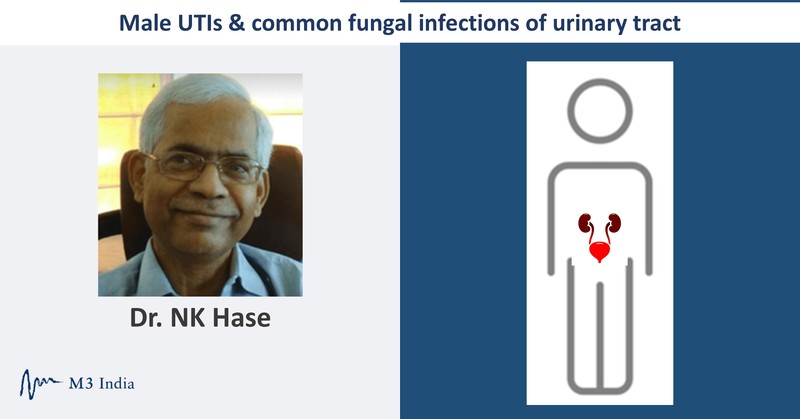Male UTIs & common fungal infections of urinary tract: Exclusive masterclass series by Dr. NK Hase- Part 3
M3 India Newsdesk Jul 22, 2020
Dr. NK Hase in the third part of his exclusive masterclass series discusses urinary tract infections in men and common fungal UTIs seen in clinical practice.

Urinary tract infections in men
Urinary Tract Infections (UTI) are rare in men as compared to women. In the male child and young male, it is usually associated with obstruction due to congenital abnormalities like posterior urethral valve, primary or secondary reflux, meatal stenosis, and neurogenic bladder. In men between15 and 50 years- anal intercourse, intercourse with women with vaginal colonisation of uropathogen, and acquired immunodeficiency syndrome with CD4 count of less than 200/mm3 are important risk factors. Elderly males predispose to UTI because of obstruction due to prostatic enlargements, voiding dysfunction due to hypoactive detrusor and diabetic cystopathy.
The classical clinical manifestations of cystitis in males consist of dysuria, urinary frequency and Suprapubic pain.
- Fever, chills, malaise suggest complicated UTI: pyelonephritis or bacterial prostatitis
- Perineal or pelvic pain radiating to the tip of the penis or obstructive symptoms such as hesitancy, dribbling, and thin stream suggest bacterial prostatitis
- Urethral discharge, burning, frequency, urgency may suggest urethritis in young males
Diagnostic test for gonorrhoea and Chlamydia Trachomatis are warranted. Men with recurrent UTI chronic prostatitis should be ruled out. Urinalysis showing pyuria and midstream urine culture showing significant bacteriuria confirms the diagnosis of UTI. All males- child, young and old should be evaluated to rule out functional and structural abnormality.
In men who have severe symptoms of cystitis with possibility of prostatitis and pyelonephritis, the preferred drugs are Levofloxacin 750 mg orally once or Ciprofloxacin 500 mg orally, twice daily or Amoxicillin 500 mg orally, 8 hourly or Trimethoprim + Sulphamethoxazole 160/800 mg orally twice daily as empiric therapy. If there is no response in 48 to 72 hours, subsequent therapy should be as per susceptibility pattern.
UTI in men is always considered as complicated UTI. Duration of therapy should be 14 days. Men with recurrent UTI require therapy for 4 to 6 weeks to eradicate focus from prostate.
Fungal infections of urinary tract
Candida species is responsible for causing the most common fungal urinary tract infection in clinical practice. Mucor mycosis, Aspergillosis and Histoplasmosis is rarely reported in renal transplant recipients.
Risk factors include:
- Uncontrolled diabetes
- Corticosteroid use in patients
- Long-term indwelling urethral catheters
- Ureteral stents
- HIV infection with low CD4 counts
- Use of immunosuppressive drugs in renal transplant patients
- Broad spectrum therapy for prolonged period
Infection may be either antigrade following candidemia or retrograde via urethra.
Clinical manifestations
They include asymptomatic candiduria cystitis, pyelonephritis, fungus balls producing obstruction in ureter, bladder, and systemic candidemia. Diagnosis by urinalysis and urine culture. Candida albicans is most common; others are Candida tropicalis, C.kruzei and C.glabarata.
Treatment
The first step is to correct underlying risk factors- control of diabetes; removal of indwelling catheter. Treatment of asymptomatic candiduria is not beneficial. Therapy is indicated in-
- Neutropenic patients
- Patients undergoing for traumatic urologic procedure
- Patients with cystitis pyelonephritis and systemic candidemia
If fungus balls are obstructing the urinary tracts surgical or endoscopic removal will be required.
Fluconazloe is the treatment of choice for Candida urinary tract infections because it is excreted in urine in active form and high urinary concentration is achieved. Fluconazloe 200 to 400 mg orally daily is recommended. Total duration of therapy should be 14 days. Fluconazloe is effective against C.albicans and C.tropicalis but not against C.kruzei and C.glabarata. This should be treated with low dose Amphotericin 10 mg/day IV plus flucytosine 100 mg/kg/day orally in divided doses for 14 days.
Patients who require indwelling catheter may be treated with Amphotericin or Nystatin bladder irrigation via three triple lumen catheterisation. Echinocandins such as Caspofungin, Micafungin and Andulafungin and other azoles- Voriconazole and Posaconazloe are not excreted in urine hence not recommended for treatment of fungal lower urinary tract infection.
To read the previous articles in this series, click-
UTI diagnosis & classification
Treatment approach to major UTI syndromes
Disclaimer- The views and opinions expressed in this article are those of the author's and do not necessarily reflect the official policy or position of M3 India.
The author Dr. NK Hase is a Director clinical Nephrology & Transplant working at Jupiter Hospital, Thane and former Professor & Head of Department of Nephrology Seth GS Medical College and KEM Hospital, Mumbai.
-
Exclusive Write-ups & Webinars by KOLs
-
Daily Quiz by specialty
-
Paid Market Research Surveys
-
Case discussions, News & Journals' summaries